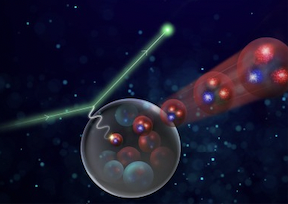’ll begin by briefly reviewing existing experiments and related theory. The bulk of the talk will be on a new approach, discussed in https://arxiv.org/abs/2104.11168, to the time dependence of putative point-like configurations moving within the nucleus. Those considerations indicate that the Feynman mechanism is responsible for the proton elastic form factor, and that the future of color...
Observation of color transparency in baryons would provide a new means to study the nuclear strong force and would be the first clear observation of hadrons fluctuating to a small size in the nucleus. This talk will present the recently published Hall C results ruling out observation of the onset of color transparency in baryons up to Q2=14.3 GeV^2. Additionally, an overview of an upcoming...
The color transparency of a hadron, propagating without absorption in a nucleus, is a fundamental property of QCD, reflecting the hadron's internal structure and the effective size of its color distribution when it is produced at high transverse momentum $Q$. By using the framework of holographic light-front QCD, one can predict the $Q^2$ behavior of the effective transverse size of the...
I give an overview of (mostly my own) work on aspects of QCD dynamics in hadronic form factors at large momentum transfer.
The topics include a discussion of basics of soft and hard mechanisms, QCD sum rule applications, calculation of meson form factors in holographic QCD, and connection of form factors to generalized parton distributions.
The recent measurements of exclusive backward-angle meson electroproduction
from Jefferson Lab hint at a new domain of applicability of the QCD collinear
factorization framework in the special u-channel kinematics regime. As a
signature of QCD degrees of freedom in nuclei, and as a co-requisite of
reaching the factorization regime, Color Transparency is expected to manifest
itself as an...
We propose to measure the pion-induced exclusive Drell-Yan process using the E50 high-resolution spectrometer in the high-momentum beamline of Hadron Hall at J-PARC. The cross sections of this reaction will provide information about the proton generalized parton distributions (GPDs) and the pion distribution amplitudes (DAs) through a timelike approach. The strategies and road maps will be sketched.
Generalized color transparency (CT) is related to QCD factorization theorems
allowing one to express cross sections of hard processes with nuclei
in terms of nuclear parton distributions. In my talk, I will review
recent studies of generalized CT in coherent photoproduction of
J/psi mesons in ultraperipheral collisions (UPCs) of heavy ions at the LHC
focusing on the leading twist nuclear...
I give an overview of work done in the relativistic multiple scattering
Glauber approximation (RMSGA) model. I focus on reactions relevant to
color transparency studies at intermediate energies, such as proton,
pion and rho knockout reactions and discuss the agreement with the world
data.
Antiproton annihilation on the bound nucleon allows to study exclusive channels
of mesonic interactions with the target residue. If the hard scale is present
then such interactions should be reduced due to the color transparency (CT).
I will discuss, first, the "golden" channel A(pbar,J/psi)(A-1)^*
for the study of the J/psi dissociation cross section on the nucleon.
Then, the d(pbar,pi^-...
Abstract: I will discuss selected topics on jet and heavy flavor production in e+p and e+A
collisions at the future Electron-Ion Collider. In the simpler e+p system I will show how precision
theory of novel energy-energy correlator observables can provide a complementary handle
on the physics of transverse momentum distributions. In e+A reactions I demonstrate the
utility of jet and...
We present the results of two experimental programs at the Alternating Gradient Synchrotron of Brookhaven National Lab, to measure the nuclear transparency of nuclei via the quasi-elastic A(p,2p) scattering process near 90° in the pp center of mass. Data was taken at effective incident momenta ranging from 5.0 to 15.8 GeV/c (taking into account the Fermi motion of the target proton in the...
By design, the (e,e’p) color transparency experiments have been done in relatively clean kinematics (parallel) where FSI effects are minimal. Also, the dominator of the transparency is a naïve function such that and one would not expect the ratio to go to unity even if there was color transparency due to initial-state effects, such as short-range correlations, which are neglected. We look...

